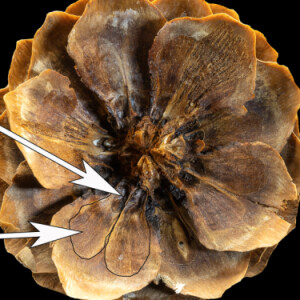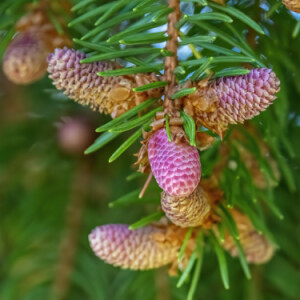IT WAS A ROUGH WINTER
It took a while for winter to get started around here but once it got going it was tons of snow late in the season and lots of wind pushing it around. Except for large parking lots in the city where the plows have piled the snow high, it's pretty well gone...always happens that way. When Spring attempts to arrive, it comes in a rush and really gets going once the Vernal Equinox arrives.
~
The front lawn is still all brown and matted and there were wind blown cones from the resident Norway Spruce (Picea abies) lying all over the place. I spent over an hour picking them up yesterday and I disposed of 353 of them.....maybe 1/10th the number still on the tree.
~
Some cones were in pieces and I thought they might make an interesting photo series. Most people are unaware that all the "pine cones" they see are females. And strangely enough, at least around here, all such cones are referred to as "pine cones" whether or not they come from pine trees. Well, these are Spruce Cones...but they serve the same purpose as pine cones or hemlock cones or redwood cones....they make seeds.
~
As I said, all the cones you see are female cones...they contain the structures (eggs) which will eventually become seeds IF pollinated. Male cones are formed near the ends of the lower branches and only in the spring time...then they dry up and blow away (see last Extra). They are often confused with new growth but they're not...they're cones. They are typically vertical as opposed to the pendulous, hanging female cones. The male cone's only job is to make pollen which contains sperm. Wind blows the pollen upward toward the female cones which are usually concentrated near the top of the tree. The pollen then meets with the egg under each bracket on the cone.
~
You undoubtedly noticed that some cone's scales are tightly closed and are likely green in color. Those are the cones that are produced this year and it's just unfortunate that they fell to the ground and will never produce viable seed. The brownish cones were produced the year before and are 2 years old.
~
After the seeds are produced a waterproof layer forms between the cone and its branch. As the cone is deprived of water, it starts to dry out and then opens up much like an umbrella and each scale opens up and allows the seeds underneath to fall out and fly away. That's why most of the cones are high up the tree...so the seeds can fly a distance away from the parent plant......which technically is the grandparent plant. Technically, the parents of the seed are the pollen (sperm) and the ovum in the cone.
~
EXTRA 1: A portion of the dried 2 year old cone showing the scales from underneath. Under each scale you'll see two scars....each scale produces 2 seeds. If there's 100 scales and all are pollinated, there will be 200 seeds per cone.
~
EXTRA 2: I've outlined the seed scars for you. If you look carefully, you will see other such scars on each exposed scale. The seed itself was located near the center shaft of the cone. You'll see the arrow showing where the seeds was.....the large wing-like scar shows where the Samara was located. It's merely a winged extension that allows the seeds to rotate like a helicopter to allow it to fly away from the tree and hopefully find a great place to grow. Without the Samara, the seeds would fall straight down and be under the tree where it couldn't compete for sunlight, etc.
~
The tree produces so many seeds because the odds of landing somewhere where conditions for growth are good are pretty low so it compensates by making lots of seeds.
~
Thus endeth the biology lesson for the day. Best viewed in Large.
~
NEW ADDITION: CHECK LAST EXTRA.....it's a photo of male cones taken in the past. Look carefully...you can see pollen grains blowing out from under the scales.




Comments
Sign in or get an account to comment.


